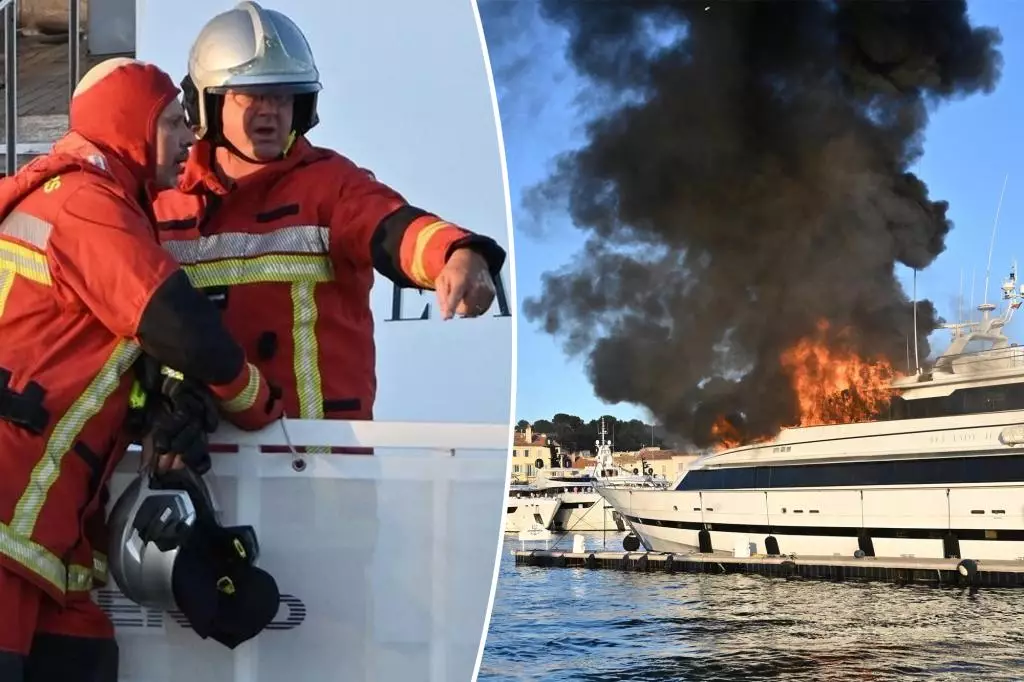In the shimmering coastal haven of Saint Tropez, the allure of wealth and extravagance paints a picture of unassailable perfection. The recent fire aboard the Sea Lady II, a multimillion-dollar superyacht, starkly exposes the fragile veneer of this glamorous world. While onlookers revel in their own luxury, their fascination with the opulent marine vessels often blinds them to the lurking dangers that come with such extravagance. The burning yacht encapsulates a paradox—the pinnacle of wealth and leisure thread with underlying peril. It’s easy to dismiss incidents like these as rare mishaps, but they underline the inherent risks that accompany a lifestyle predicated on high-stakes investments, complex machinery, and the high-octane pursuit of pleasure.
The Hidden Perils of Superyacht Ownership
Superyachts, often viewed as symbols of status and success, are technological marvels—designed with intricate systems, luxurious amenities, and cutting-edge safety features. Yet, their sophistication poses significant risks. Fires are one of the most catastrophic threats, often sparked by engine malfunctions, electrical faults, or human error. The Sea Lady II’s fire, which resulted in the rescue of two crew members suffering smoke inhalation, is a reminder that even the most meticulously maintained vessels are vulnerable. The tragic reality is that the sheer size and complexity of these vessels make firefighting efforts more daunting, especially in port where space and access constraints complicate rescue operations. This fire underscores the other side of luxury—an underlying fragility that can swiftly turn dream vacations into disasters.
The Resilience and Apathy of the Elite Scene
Despite the chaos unfolding nearby, the social scene in Saint Tropez maintained its lively pulse. Partygoers and tourists, instead of retreating from danger, continued their revelry unabated. This indifference reveals an unsettling truth about the mindset of the wealthy: an almost detached sense of invincibility. Wealthier individuals often view their possessions—like iconic yachts—as untouchable, immune to mishaps that could devastate others. The image of crowds lining up to watch the blaze, masks on their faces from lingering smoke, exemplifies a culture where spectacle and status take precedence over safety. Such attitudes perpetuate a dangerous narrative—that luxury is synonymous with permanence, regardless of underlying vulnerabilities.
The Environmental and Human Toll
The consequences of a yacht fire extend beyond the immediate danger. The deployment of anti-pollution barriers signifies environmental concerns—oil spills, fuel leaks, and debris threaten marine ecosystems. The rescue of crew members highlights the human toll, a sobering reminder that behind the glamour are individuals risking their lives for luxury and profit. Additionally, the recurrence of yacht fires—such as the 2017 blaze near Pampelonne beach—illustrates that these risks are not isolated incidents but part of a troubling pattern. The environmental damage and human safety issues are often overshadowed by the media’s focus on wealth, yet they are critical problems demanding acknowledgment and action.
The Cultural Facade of the French Riviera
Saint Tropez’s image as a playground for celebrities and the jet set fosters a culture of relentless luxury tourism. The influx of stars like Kylie Jenner, Timothée Chalamet, and Kendall Jenner exemplifies this high-profile obsession with opulence. These sightings reinforce the perception that wealth and glamour are inseparable from the Riviera’s identity. However, beneath this veneer lies a less glamorous reality—one where material excess contributes to environmental degradation, safety hazards, and social disparity. The sight of celebrities vacationing amidst the incident subtly reveals the disconnect between the privileged and the perils they often overlook or dismiss. This paradox challenges the notion that wealth automatically equates to security and control.
Reflections on Wealth, Risk, and Responsibility
The Sea Lady II incident prompts a broader reflection on the responsibilities that come with affluence. While ownership of a luxury yacht symbolizes success, it also comes with moral and practical obligations—ensuring safety, minimizing environmental impact, and acknowledging that even the most glamorous lifestyle harbors vulnerabilities. The reckless celebration of wealth, especially in a culture that often dismisses the risks, fosters a dangerous narrative. As climate change intensifies and safety standards evolve, the luxury industry must confront its role in promoting responsible stewardship. The fire on the Sea Lady II, and similar incidents, serve as stark lessons—wealth does not make one immune, and safety is a shared responsibility that cannot be overlooked in the pursuit of pleasure and prestige.

